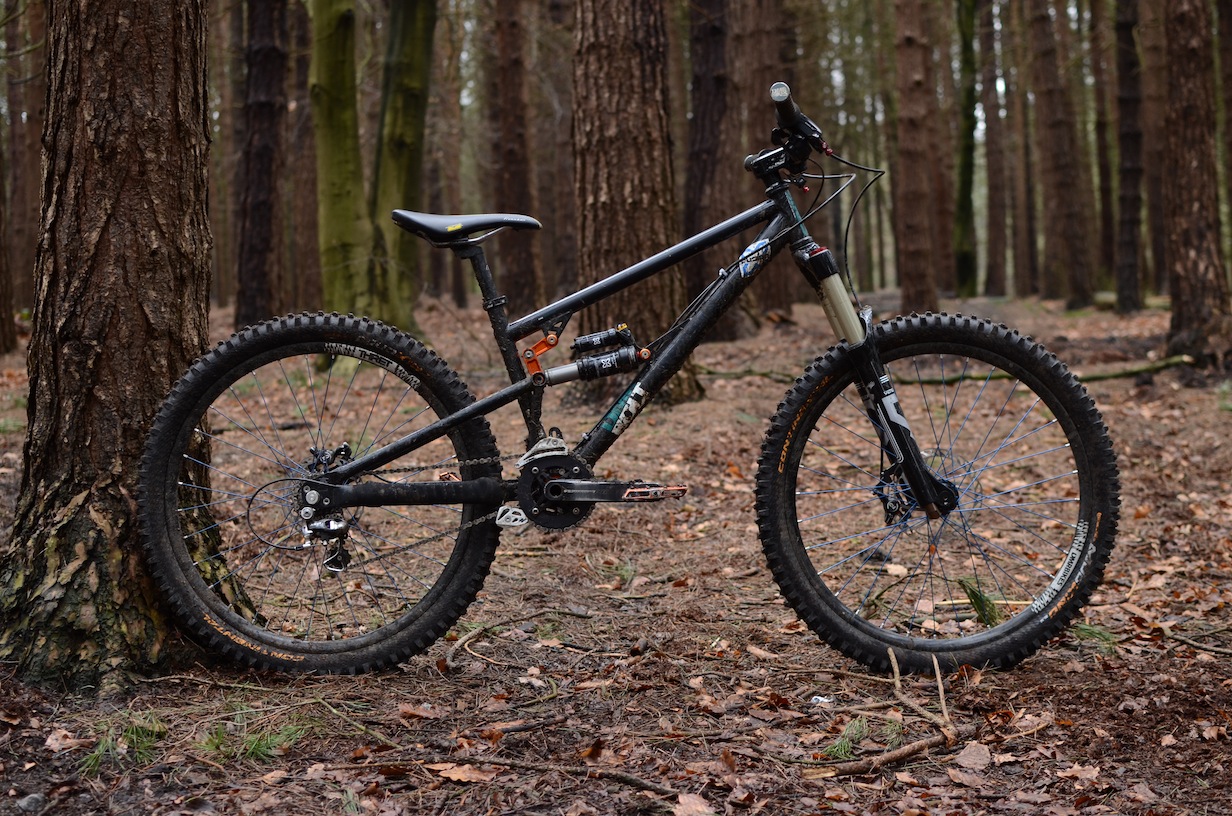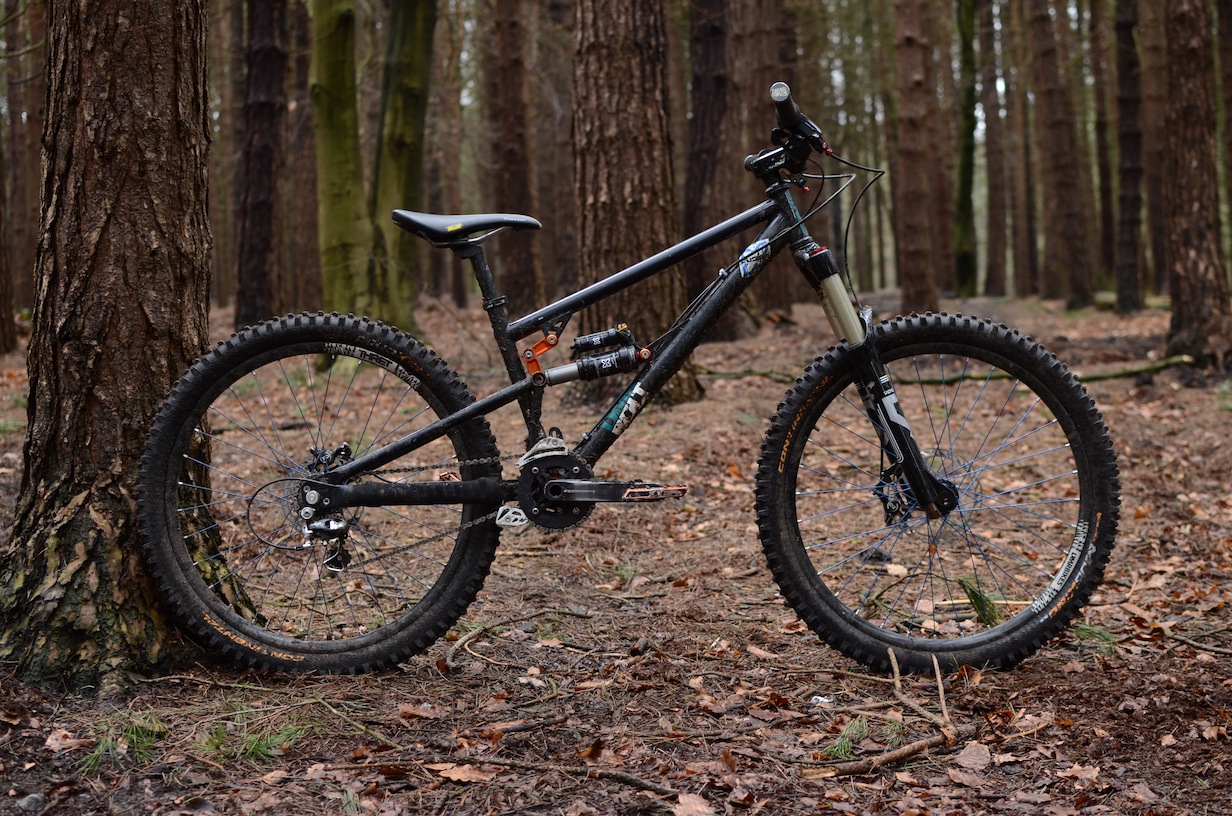
Weight: 35 lbs as depicted (9.1 lbs frame only)
Persona: You, twenty years ago
DMR concern themselves with making no-nonsense but cool-looking play bikes. They’re not really that bothered about covering every single MTB niche or flavour of the month. This is a rare and excellent attitude. They like dirt jump bikes and rag ’em ‘ard trail bikes. Almost always they’re steel hardtails.
The full-suspension DMR Bolt is both a departure from this stance and yet also a confirmation and continuation.
The Detail
Having 125mm of bounce at the back is a new thing on a DMR. The rear swingarm pivots around the BB. In theory suspension systems that pivot around the bottom bracket should be prone to pedalling-induced bob. The main (only?) reason for opting for this hard-to-execute pivot placement is so that riders can run the bike as a singlespeed. When I say “riders” I should really say “dirt jumpers”.
The rear dropouts have the same attachment method as all of DMR’s ‘SwopOut’ dropouts so it’s pretty straightforward to put horizontal dropouts on the Bolt. As it is, this test bike came with a 1×9 drivetrain and a bolt-thru rear axle. Chunky. There are ISCG05 tabs on the BB shell, as you’d expect on a DMR.
The rear suspension swinglink is chunky but crisply made. DMR haven’t used a linkage to do anything specific to the spring rate or anything. The linkage is there to stiffen and strengthen things up. The ‘ultra high load, spherical bearing, shock pivot’ is similarly all about the sturdiness.
What isn’t new on a DMR is a frame made from clouty steel tubing. The Bolt is indeed made from the same sort of steel that DMR’s hardtails are made from. This doesn’t make for a light frame (9.1 lbs in fact) but then again, light weight hasn’t really been a priority for this bike really. It’s about strength and ride characteristics. Dirt jumpers – and a certain breed of trail raggers – appreciate the feel of chunky 4130 cromoly. Stout but not spiky harsh. A little bit of muted ‘give’ here and there. No doubt this sort of ‘chassis feel’ isn’t so detectable or important on a full susser but there are riders out there who’d say that the ‘steelness’ is still there to be felt.
And let’s be frank, the steel tubes do give the bike its aesthetic. It looks like a DMR. And it’s a particularly “I want a go on that” DMR too.
Some geometry numbers: 68° head angle, 73° seat angle, 22.4in actual top tube, 14.4in seat tube, 13.5in BB height, 115mm head tube, 17.1in chain stays.
The Bolt is currently only available in one size. But happily DMR are making a ‘longer front triangle’ option too. Yay for lanky riders.
There is even talk of a titanium Bolt and the new Bolt frames now come with tapered steerer friendly head tubes too.
http://vimeo.com/38157805
The finishing kit is all DMR branded stuff or stuff from their distributor, Upgrade. TRP Dash disc brakes are great. The X-Fusion Vengeance fork is great (review here). The fork on this test bike has been internally reduced in travel to 140mm by the way. The X-Fusion Vector Air HLR is not the basic spec’d shock, it’s an upgrade over the standard X-Fusion O2 RL. Speccing this fancier shock does have a significant affect on how the Bolt rides.
The Ride
So how does it ride? The short answer is: amazingly like a hardtail. A slightly longer answer is: amazingly like a hardtail but so much faster when you get it on proper trails. I won’t pretend to have done any dirt jump sessions with the Bolt. What I have done is take the Bolt out on several ‘technical trail’ and ‘titting about’ rides. Where it’s fair to say, I developed a rather large, and wholly unexpected, crush on the Bolt.
Truth be told, I had half expected the Bolt to be an overly heavy, soggy bobby, ‘pointless’ bike. Albeit a cool looking one.
After the first corner, on the first descent, I was instantly converted. The Bolt just ripped around it. I had my inside foot all primed and ready to deal with a bit of washout tripoding, but there was no need. On to the next corner, trying to see how far over I could get. Same again, no fuss. It just slingshot around. The immense amount of standover was a great help here.
Rooty corners? Bring ’em on. Buff berms? Love ’em.
There was much more traction than a hardtail. Dig down with your heels and the tyres just obey. But the Bolt is no lifeless steamroller. There is loads of feel to be had. Whether you want to drift or stick is up to you. There’s much less dip and wallow than with some full sus designs. No odd things happening with pedal feedback when stamping out of the other side of corners. No real sense of delay to pedal input either.
Coming from a few months of riding other full sus designs I was surprised by just how much my riding took into account chain/pedal feedback. Getting on the Bolt, which exhibited none of this, felt great. Again, like a hardtail. No chaingrowth weirdness. There was a consistency to the feel of the whole stroke of the travel too. It felt the same at all points in its travel.
Oh look! There’s a lip – POP! The Bolt exhibits just the same kind of alacrity for airtime as DMR’s best hardtails. The back end doesn’t seem to blunt any takeoff energy. But there’s definitely 125mm of well controlled travel to be had when you touch down on the other side.
The X-Fusion Vector Air HLR played a big part in this handling. Although it’s a £200 upgrade I wouldn’t hesitate to say it’s worth it. The key thing it has over the standard O2 RL shock is adjustable low speed compression.
When I ran the Vector shock with minimal low speed compression damping dialled in, while it wasn’t the bobby mess I thought it might be, it didn’t have as much pop and pluck as it did when running some low speed compression. It didn’t need loads of compression, just enough to stop it from excessive bobbing on climbs. While the Bolt should never be about ‘climbing ability’, a bobby back-end robs you of energy that you want to have for playing out as long as possible. And you will want to play out on the Bolt until your legs fall off. Firming up the low speed damping also gives the bike just a bit more punch when you’re working the trail.
Heavier riders and/or riders who want to do massive jumps on the Bolt will be better served by the Vector Air HLR shock too. The adjustable piggyback is there to tune how the shock behaves on The Big Stuff.
Overall: I wouldn’t recommend the Bolt as an all-rounder, or to have as your main bike. It’s just too heavy to take out on pedalley rides (there isn’t a seatpost in the world long enough for taller riders either). And it’s not quite capable enough to mix it with DH bikes on push-uphill ‘gravity days’. Would I have one? Absolutely. In a second. Oh God yes. No thought required. I may not ride it week-in week-out. But for certain types of rides, certain types of trails, certain types of attitude even, the DMR Bolt would be my number one choice. A pointless bike? Fun is never pointless.







